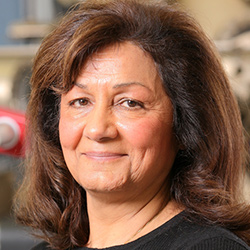Novel Type-II Superlattice Exploits Phototransistors
Professor Manijeh Razeghi publishes new research in Applied Physics Letters
Northwestern Engineering’s Manijeh Razeghi, Walter P. Murphy Professor of Electrical Computer Engineering, has developed a novel type-II superlattice (T2SL) based heterojunction phototransistor (HPT) device as a possible solution to the urgent demand for sensitive photodetectors for free-space optical communication as well as high-speed sensitive imagers.
As a pioneer research group in growth and implementing T2SL based devices, Razeghi and her team at the Center for Quantum Devices (CQD) demonstrated a newly developed InAs/AlSb/GaSb T2SLs-based HPT, which can take advantage of the extreme bandstructure tunability of T2SL material system to deliver low noise and large optical conversion gain for the HPT device.
Supported by the Defense Advanced Research Projects Agency (DARPA), the Army Research Laboratory, and NASA, the team's paper, “Extended Short Wavelength Infrared Heterojunction Phototransistors Based on Type II Superlattices” was published on May 17 in Applied Physics Letters.
 “For the first time, by using a well-designed band structure-engineering approach, we showed capability of T2SL based device to cover e-SWIR region for HPT devices,” said Razeghi, director of CQD.
“For the first time, by using a well-designed band structure-engineering approach, we showed capability of T2SL based device to cover e-SWIR region for HPT devices,” said Razeghi, director of CQD.
Extended short-wavelength infrared (e-SWIR) photodetectors are of great interest for many applications such as medical imaging, astronomy, light detection and ranging (LiDAR), quantum computing, and single photon detection. By extending short wavelength infrared toward longer wavelength cutoff to cover up to 2.5 μm (e-SWIR), it allows superior transmission through common atmospheric obscurants such as fog, clouds, dust, and smoke.
CQD’s unique T2SL HPT device has nanoscale base region to provide better emitter injection efficiency. By using precise band alignment for the HPT quantum structure, the device can reach injection efficiencies close to unity since the reverse injection from base is blocked by hetero-barrier designed by band gap engineering.
“This novel design can be an excellent alternative to be used for high-speed devices," said Razeghi whose group has spent many years working to develop an understanding of the physics of new semiconductor materials for novel applications and realizing advanced semiconductor devices such as lasers, photodetectors, transistors, waveguides, and switches.
CQD’s progress can open the prospect of implementing T2SL–based e−SWIR phototransistor with superior sensitivity, responsivity, and speed performance in various ranges of wavelengths. It also can be a promising and feasible candidate for current state-of-the-art infrared detection for highly sensitive and fast imaging technologies at e-SWIR range for various imaging applications.

